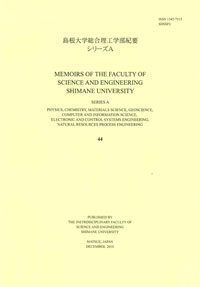島根大学総合理工学研究科
ISSN:1342-7113

number of downloads : ?
Use this link to cite this item : https://ir.lib.shimane-u.ac.jp/3590
Memoirs of the Graduate School of Science and Engineering Shimane University. Series A 30
1997-03-25 発行
鉄鉱石溶解還元プロセスにおけるメタル成分の挙動とそれを制御する条件
Behaviour of Metal Compositions and Conditions Determing Them in Smelting Reduction of lron Ore
File
Description
The behavior of impurities (carbon, phosphorus, sulphur and nitrogen) in a smelting reduction process was investrgated by 5 ton and 100 ton scale experiments.
(1) In the case of almost carbon-saturated iron, the phosphorus content in the metal can be reduced below 0.02% (min.0.004%) by controlling the (T. Fe) content in the slag above 4-5% and the bath temperature below 1450℃.
(2) More than 60% of input sulphur evaporated during smelting reduction, most of which were captured into the dust as FeS. The distribution of the remaining sulphur between slag and metal can be expressed as follows.
log (S)/[S] = -3032/T-0.343 log (% T. Fe)
+ 0.660{[(% CaO) + (% MgO)]/[(% SiO_2)+ (% Al_2O_3)]} + 1.431
(3) The carbon content in the metal depends on the sort of carbonaceous materials and operational conditions such as the intensity of bottom stirring. The change in carbon content can be explained by the balance between carburization (which is determined by the distribution of carbonaceous materials and metal droplets in the slag layer) and decarburization (that is, reduction rate of iron ore by carbon in the metal).
(4) In order to improve the removal of impurities in the smelting reduction process, it is desirable to operate at more than 3% of carbon content. There are two typical operational methods, one of which is concentrated in dephosphorization and another is in desulphurization.
(1) In the case of almost carbon-saturated iron, the phosphorus content in the metal can be reduced below 0.02% (min.0.004%) by controlling the (T. Fe) content in the slag above 4-5% and the bath temperature below 1450℃.
(2) More than 60% of input sulphur evaporated during smelting reduction, most of which were captured into the dust as FeS. The distribution of the remaining sulphur between slag and metal can be expressed as follows.
log (S)/[S] = -3032/T-0.343 log (% T. Fe)
+ 0.660{[(% CaO) + (% MgO)]/[(% SiO_2)+ (% Al_2O_3)]} + 1.431
(3) The carbon content in the metal depends on the sort of carbonaceous materials and operational conditions such as the intensity of bottom stirring. The change in carbon content can be explained by the balance between carburization (which is determined by the distribution of carbonaceous materials and metal droplets in the slag layer) and decarburization (that is, reduction rate of iron ore by carbon in the metal).
(4) In order to improve the removal of impurities in the smelting reduction process, it is desirable to operate at more than 3% of carbon content. There are two typical operational methods, one of which is concentrated in dephosphorization and another is in desulphurization.
About This Article
NCID
AA11157087
Other Article
PP. 27 - 38
PP. 63 - 73
PP. 125 - 139
PP. 141 - 148
PP. 149 - 160
